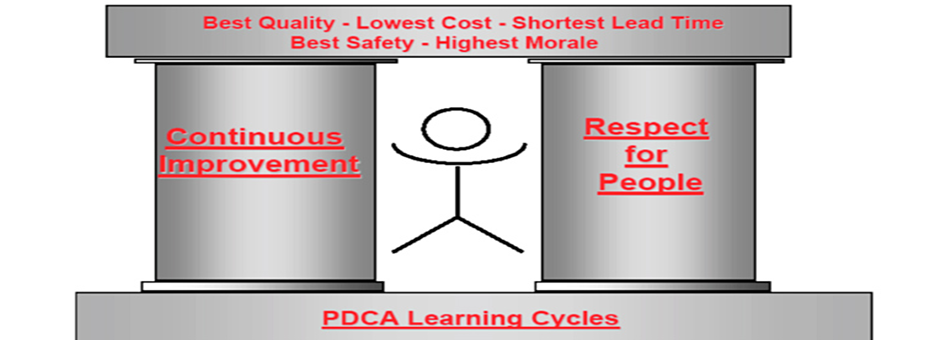Respect for people and its cousin the dignity of work are central to lean practice. Two years ago, we published a roundup of articles exploring this theme and since then have explored it frequently enough to post this roundup of articles published.
These articles can help you develop a practical and mindful approach toward coaching others to improve the work. This benign aspiration cannot be achieved through polite behaviors alone but must be anchored in an intentional engagement with the work and the worker. This approach can be grounded in mutual observation and experimentation, guided by a disciplined method of improvement.
These articles can help you develop a practical and mindful approach toward coaching others to improve the work. It cannot be overemphasized that improving the work always starts with an intense exploration of the work itself: “Lean is a ‘learn by doing’ exercise and not a classroom training approach,” says Art Byrne in his Ask Art column Am I Showing Respect for People by Asking for Fast Action? A veteran of more than 30 lean transformations at Wiremold and other companies he led through private equity work, Byrne has found that sustained kaizen activity targeted at aggressive tangible improvements engages every individual in understanding and improving the work. Every person must learn and contribute their improvement ideas to the team, he says, noting that “the more kaizens you do, the faster this teamwork spreads.”
Fostering respect for people involves a huge shift in managerial thinking, to be sure. Amy Edmondson suggests that a conscious effort to shift how leaders “frame the work” has enormous leverage. In her Frame the Work for Safety and Learning, she defines frames as assumptions or beliefs that we layer onto reality, and notes that focusing on short-term issues often blinds us to “the effects of our cognitive frames on our interpretation of what we see.”
She calls upon leaders to be aware of and manage such frames intentionally. Different types of work call for different framing. “If near-perfection is what is needed to satisfy demanding car customers, leaders must know to frame the work by alerting workers to the opportunity to catch and correct tiny deviations before the car goes down the assembly line,” she writes. “Workers must adapt a kaizen frame that celebrates the value of learning—to become willing to engage in the unnatural act of speaking up about tiny imperfections.”
Touching upon a favorite topic of framing failure, she notes that good (pro-learning and improvement) leaders create a sense of psychological safety, communicating to people that failure is okay, convincing everyone that, “I’m not pro-failure, I’m pro-learning.”
Respect Can Show Up…Quietly
Again, enacting respect for people is less of a challenge involving etiquette and protocol and more of a deep reflection on pursuing tangible ways of leading and managing. Matt Savas’s great article The Quiet Factory shares his wonder at something that he did not hear at his gemba walk at Toyota Motor Kyushu (TMK): noise.
TMK has established noise reduction as a corporate objective to create a better work environment for its workers, he says. From a quality perspective, he notes that a quieter factory means that workers are better able to hear the tell-tale clicks and pops that subtly indicate when operations are running smoothly. Moreover, the broader challenge of maintaining a dynamic workforce in an aging Japanese population has led the company to respond with countermeasures designed for their current workforce.
Savas shows a tint of awe for how the company has married its core value of respect for people with a pressing outside challenge, Enacting respect for people is less of a challenge involving etiquette and protocol and more of a deep reflection on pursuing tangible ways of leading and managing. tackling these goals by tangibly creating a factory with less audible waste. “Toyota faces a major external challenge (tightening labor market) and has addressed it by creating a major internal challenge (reducing factory noise).”
Katrina Appell builds on this theme of pragmatic approaches to respect in her article on How to Show Respect During a Pandemic. Like any core lean ideal, to have leaders showing respect for people each day calls for a collaborative practice rather than a top-down (and potentially self-congratulatory) exercise.
For example, candid feedback on ongoing performance is crucial. “The risk to leaders who misinterpret showing respect as being nice is that they will not give people the feedback they need to learn and improve,” she says. By working to understand the current work situation first, through asking the worker what is going on, leaders deepen every person’s grasp of the current state and provide the foundation for developing a person’s capabilities and maximizing individual and team performance.
(Note: Katrina has expanded on these thoughts in a terrific article on her blog.)
Simply Listening Can Be A Loud First Step
Asking workers for their input can be tougher and more counter-intuitive than one imagines, shares lean leader Joel Daly—but can ultimately result in dramatic shared improvement. His simple tale of Showing Respect: Here’s How Emmanuel Proposed A More Reliable Shipping Rack details how a dramatic improvement in the company’s shipping racks came about when Joel…asked his workers to help with this problem.
After a worker was injured from interacting with the company’s shipping racks, Joel took the radical step of raising this topic in a daily huddle. He was surprised later to find a detailed plan for a more reliable shipping rack created by Emmanuel, who had taken the initiative to meet with other group leads and sketched out a potential countermeasure. For Daly, this was a revelation about “uncovering neglected human potential.” Grateful for the circumstances leading to his inquiry, he says: “It was precisely because of the problem, not in spite of it, that we realized we had another great lean thinker on our team.”
Creating an environment of respect boils down to ensuring that all workers—as professionals—have working conditions that monitor what they need to get their job done. Such isolated examples of showing respect aggregate into a broader and more comprehensive organizational mindset. Respect for people can be seen as a systems approach to managing others that managers create with rigorous tools and techniques. In his article Active Caring, Jim Benson cites how Turner Construction ensures organizational respect by creating what it calls The Right Environment. “This is a precursor to continuous improvement that makes sure that people not only have agency but that they have a social system that respects them and expects them, as professionals, to act on that agency.”
This approach boils down to ensuring that all workers—as professionals—have working conditions that monitor what they need to get their job done. At a one billion dollar construction project, this translated into an onsite trailer where daily huddles of teams and subteams would start the day with calisthenics, a safety initiative to prevent injuries. This daily routine was just a precursor to get aligned on specific work targets and how they were achieving them. Reviewing the actual daily practices manifesting their values became a natural habit.
Benson notes that creating an environment in which a system (one that, say, respects people) can operate is an essential first step.
“Above all, you can see the desire of the people in the trailer to extend the gifts that they had given themselves by setting up the right environment. This tells me that if you give somebody not just permission to pay attention and be nice, but you actually give them a system that expects that, then that becomes part of their job. After that, no one ever needs accountability because the system itself has now fostered professional responsibility. It’s absolutely beautiful.
This system provides what is pretty close to immediate feedback. It supports the shared expectation that everyone’s job is to make sure that the building is built safely, on time, on budget, in a humane way. And the shared work approach continually monitors the key challenge of, ‘how can I personally make today better than yesterday?’”
*****
What to do next:
Are you ready for a division- or organization-wide transformation? Learn more about LEI’s Co-Learning Partnership program.




